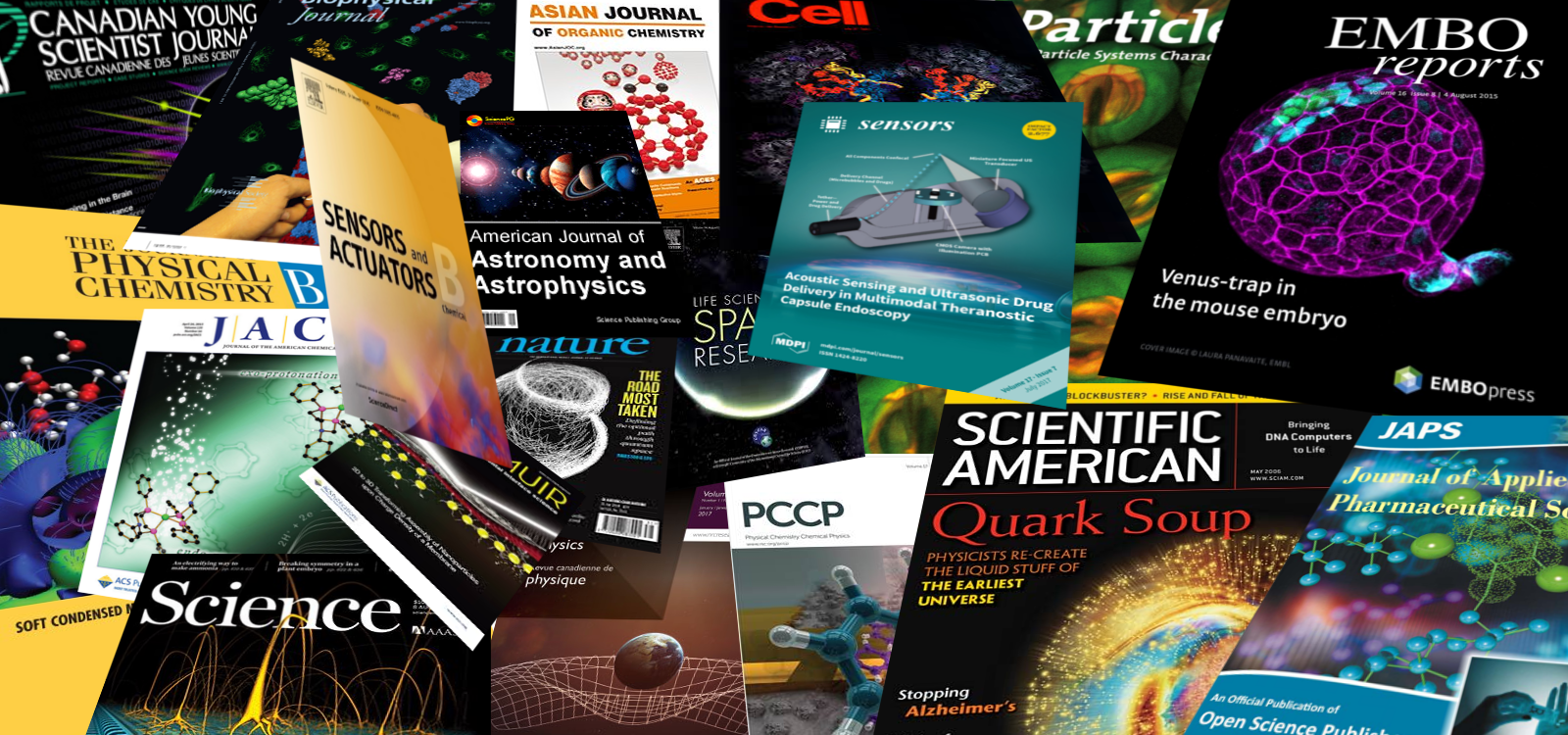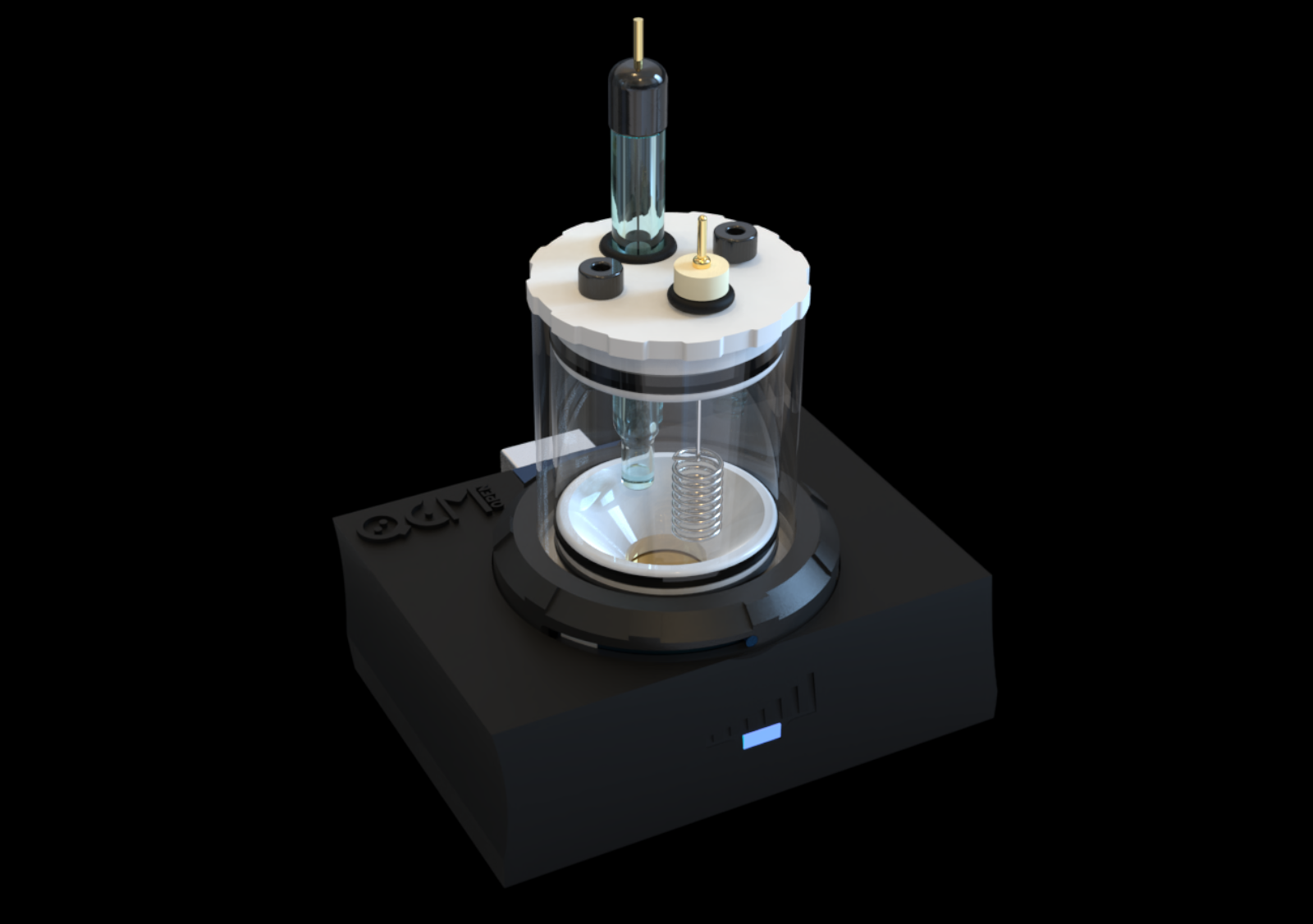openQCM – Powered by Novaetech S.r.l

Scientific Papers
Publications citing the applications of openQCM (by Novaetech S.r.l.) instruments and accessories in scientific research.
The list of scientific papers published on the most important journals showing the usage of openQCM in several scientific fields, such as thin film deposition, chemical sensors, biological research and biosensors.
Because of the large number of publications, we are reorganizing everything by subject areas. This will take some time. Thank you for your patience
2025
Macklin, Jack; Pfrang, Christian; Wady, Paul; Liu, Wanli; Davidson, Ruaridh; Milsom, Adam; Squires, Adam
In: Langmuir, vol. 0, no. 0, pp. null, 2025, (PMID: 40235269).
Abstract | Links | BibTeX | Tags: humidity, lipids, openQCM Holder, openQCM Q-1, QCM, Quartz Crystal Microbalance, Thickness, Thin films, Water
@article{doi:10.1021/acs.langmuir.4c05158,
title = {Use of Humidity Controlled Quartz Crystal Microbalance with Simultaneous Grazing Incidence Small Angle X-ray Scattering to Investigate the Self-assembly and Energetics of Lipid Thin Films},
author = {Jack Macklin and Christian Pfrang and Paul Wady and Wanli Liu and Ruaridh Davidson and Adam Milsom and Adam Squires},
url = {https://doi.org/10.1021/acs.langmuir.4c05158},
doi = {10.1021/acs.langmuir.4c05158},
year = {2025},
date = {2025-04-16},
urldate = {2025-04-16},
journal = {Langmuir},
volume = {0},
number = {0},
pages = {null},
abstract = {We present a novel method of analyzing lyotropic liquid crystal mesophases─self-organized amphiphile-water nanomaterials─using in situ grazing-incidence small-angle X-ray scattering (GI-SAXS) on a quartz crystal microbalance (QCM) in a controlled humidity environment. This combination simultaneously gives nanostructural dimensions and phase symmetry (through SAXS), compositional data (% water by weight, from QCM data), and water activity within the sample (from the equilibrium relative humidity above the film), as the sample film takes up and releases water during humidity sweeps. Analysis of the combined data provides immediate access to information typically built up from experiments on multiple individual samples prepared at different fixed compositions. Our approach greatly reduces the required sample quantities and preparation time while avoiding issues with sample-to-sample variations thanks to the collection of the multiple parameters simultaneously. It also extends the accessible range to the low water content region of the phase diagram, which is harder to access by fixed composition measurements and is highly relevant to coatings and powders exposed to ambient humidities. Here, we present data on dimyristoylphosphatidylcholine/water lamellar phases. Our calculated bilayer thickness and interbilayer repulsion values show good agreement with published data obtained from multiple individual samples, and we clearly demonstrate the ability to extend to lower water contents.},
note = {PMID: 40235269},
keywords = {humidity, lipids, openQCM Holder, openQCM Q-1, QCM, Quartz Crystal Microbalance, Thickness, Thin films, Water},
pubstate = {published},
tppubtype = {article}
}
We present a novel method of analyzing lyotropic liquid crystal mesophases─self-organized amphiphile-water nanomaterials─using in situ grazing-incidence small-angle X-ray scattering (GI-SAXS) on a quartz crystal microbalance (QCM) in a controlled humidity environment. This combination simultaneously gives nanostructural dimensions and phase symmetry (through SAXS), compositional data (% water by weight, from QCM data), and water activity within the sample (from the equilibrium relative humidity above the film), as the sample film takes up and releases water during humidity sweeps. Analysis of the combined data provides immediate access to information typically built up from experiments on multiple individual samples prepared at different fixed compositions. Our approach greatly reduces the required sample quantities and preparation time while avoiding issues with sample-to-sample variations thanks to the collection of the multiple parameters simultaneously. It also extends the accessible range to the low water content region of the phase diagram, which is harder to access by fixed composition measurements and is highly relevant to coatings and powders exposed to ambient humidities. Here, we present data on dimyristoylphosphatidylcholine/water lamellar phases. Our calculated bilayer thickness and interbilayer repulsion values show good agreement with published data obtained from multiple individual samples, and we clearly demonstrate the ability to extend to lower water contents.
2024
Karchilakis, Georgios; Varlas, Spyridon; Johnson, Edwin C; Norvilaite, Oleta; Farmer, Matthew AH; Sanderson, George; Leggett, Graham J; Armes, Steven P
Capturing Enzyme-Loaded Diblock Copolymer Vesicles Using an Aldehyde-Functionalized Hydrophilic Polymer Brush Journal Article
In: Langmuir, 2024.
Abstract | Links | BibTeX | Tags: Adsorption, openQCM NEXT, peptides, proteins, QCM-D, Quartz Crystal Microbalance, RAFT polymerization, Thickness, Vesicles
@article{karchilakis2024capturing,
title = {Capturing Enzyme-Loaded Diblock Copolymer Vesicles Using an Aldehyde-Functionalized Hydrophilic Polymer Brush},
author = {Georgios Karchilakis and Spyridon Varlas and Edwin C Johnson and Oleta Norvilaite and Matthew AH Farmer and George Sanderson and Graham J Leggett and Steven P Armes},
url = {https://pubs.acs.org/doi/full/10.1021/acs.langmuir.4c01561},
doi = {https://doi.org/10.1021/acs.langmuir.4c01561},
year = {2024},
date = {2024-06-27},
urldate = {2024-06-27},
journal = {Langmuir},
publisher = {ACS Publications},
abstract = {Compared to lipids, block copolymer vesicles are potentially robust nanocontainers for enzymes owing to their enhanced chemical stability, particularly in challenging environments. Herein we report that cis-diol-functional diblock copolymer vesicles can be chemically adsorbed onto a hydrophilic aldehyde-functional polymer brush via acetal bond formation under mild conditions (pH 5.5, 20 °C). Quartz crystal microbalance studies indicated an adsorbed amount, Γ, of 158 mg m–2 for vesicle adsorption onto such brushes, whereas negligible adsorption (Γ = 0.1 mg m–2) was observed for a control experiment conducted using a cis-diol-functionalized brush. Scanning electron microscopy and ellipsometry studies indicated a mean surface coverage of around 30% at the brush surface, which suggests reasonably efficient chemical adsorption. Importantly, such vesicles can be conveniently loaded with a model enzyme (horseradish peroxidase, HRP) using an aqueous polymerization-induced self-assembly formulation. Moreover, the immobilized vesicles remained permeable toward small molecules while retaining their enzyme payload. The enzymatic activity of such HRP-loaded vesicles was demonstrated using a well-established colorimetric assay. In principle, this efficient vesicle-on-brush strategy can be applied to a wide range of enzymes and functional proteins for the design of next-generation immobilized nanoreactors for enzyme-mediated catalysis.},
keywords = {Adsorption, openQCM NEXT, peptides, proteins, QCM-D, Quartz Crystal Microbalance, RAFT polymerization, Thickness, Vesicles},
pubstate = {published},
tppubtype = {article}
}
Compared to lipids, block copolymer vesicles are potentially robust nanocontainers for enzymes owing to their enhanced chemical stability, particularly in challenging environments. Herein we report that cis-diol-functional diblock copolymer vesicles can be chemically adsorbed onto a hydrophilic aldehyde-functional polymer brush via acetal bond formation under mild conditions (pH 5.5, 20 °C). Quartz crystal microbalance studies indicated an adsorbed amount, Γ, of 158 mg m–2 for vesicle adsorption onto such brushes, whereas negligible adsorption (Γ = 0.1 mg m–2) was observed for a control experiment conducted using a cis-diol-functionalized brush. Scanning electron microscopy and ellipsometry studies indicated a mean surface coverage of around 30% at the brush surface, which suggests reasonably efficient chemical adsorption. Importantly, such vesicles can be conveniently loaded with a model enzyme (horseradish peroxidase, HRP) using an aqueous polymerization-induced self-assembly formulation. Moreover, the immobilized vesicles remained permeable toward small molecules while retaining their enzyme payload. The enzymatic activity of such HRP-loaded vesicles was demonstrated using a well-established colorimetric assay. In principle, this efficient vesicle-on-brush strategy can be applied to a wide range of enzymes and functional proteins for the design of next-generation immobilized nanoreactors for enzyme-mediated catalysis.
2023
Brotherton, Emma E; Johnson, Edwin C; Smallridge, Mark J; Hammond, Deborah B; Leggett, Graham J; Armes, Steven P
Hydrophilic Aldehyde-Functional Polymer Brushes: Synthesis, Characterization, and Potential Bioapplications Journal Article
In: Macromolecules, 2023.
Abstract | Links | BibTeX | Tags: Functionalization, Monomers, peptides, proteins, QCM, Thickness, X-ray, X-ray photoelectron spectroscopy
@article{brotherton2023hydrophilic,
title = {Hydrophilic Aldehyde-Functional Polymer Brushes: Synthesis, Characterization, and Potential Bioapplications},
author = {Emma E Brotherton and Edwin C Johnson and Mark J Smallridge and Deborah B Hammond and Graham J Leggett and Steven P Armes},
url = {https://pubs.acs.org/doi/full/10.1021/acs.macromol.2c02471},
doi = {https://doi.org/10.1021/acs.macromol.2c02471},
year = {2023},
date = {2023-02-22},
urldate = {2023-01-01},
journal = {Macromolecules},
publisher = {ACS Publications},
abstract = {Surface-initiated activators regenerated by electron transfer atom transfer radical polymerization (ARGET ATRP) is used to polymerize a cis-diol-functional methacrylic monomer (herein denoted GEO5MA) from planar silicon wafers. Ellipsometry studies indicated dry brush thicknesses ranging from 40 to 120 nm. The hydrophilic PGEO5MA brush is then selectively oxidized using sodium periodate to produce an aldehyde-functional hydrophilic PAGEO5MA brush. This post-polymerization modification strategy provides access to significantly thicker brushes compared to those obtained by surface-initiated ARGET ATRP of the corresponding aldehyde-functional methacrylic monomer (AGEO5MA). The much slower brush growth achieved in the latter case is attributed to the relatively low aqueous solubility of the AGEO5MA monomer. X-ray photoelectron spectroscopy (XPS) analysis confirmed that precursor PGEO5MA brushes were essentially fully oxidized to the corresponding PAGEO5MA brushes within 30 min of exposure to a dilute aqueous solution of sodium periodate at 22 °C. PAGEO5MA brushes were then functionalized via Schiff base chemistry using an amino acid (histidine), followed by reductive amination with sodium cyanoborohydride. Subsequent XPS analysis indicated that the mean degree of histidine functionalization achieved under optimized conditions was approximately 81%. Moreover, an XPS depth profiling experiment confirmed that the histidine groups were uniformly distributed throughout the brush layer. Surface ζ potential measurements indicated a significant change in the electrophoretic behavior of the zwitterionic histidine-functionalized brush relative to that of the non-ionic PGEO5MA precursor brush. The former brush exhibited cationic character at low pH and anionic character at high pH, with an isoelectric point being observed at around pH 7. Finally, quartz crystal microbalance studies indicated minimal adsorption of a model globular protein (BSA) on a PGEO5MA brush-coated substrate, whereas strong protein adsorption via Schiff base chemistry occurred on a PAGEO5MA brush-coated substrate.},
key = {Functionalization,Monomers,Peptides and proteins,Thickness,X-ray photoelectron spectroscopy},
keywords = {Functionalization, Monomers, peptides, proteins, QCM, Thickness, X-ray, X-ray photoelectron spectroscopy},
pubstate = {published},
tppubtype = {article}
}
Surface-initiated activators regenerated by electron transfer atom transfer radical polymerization (ARGET ATRP) is used to polymerize a cis-diol-functional methacrylic monomer (herein denoted GEO5MA) from planar silicon wafers. Ellipsometry studies indicated dry brush thicknesses ranging from 40 to 120 nm. The hydrophilic PGEO5MA brush is then selectively oxidized using sodium periodate to produce an aldehyde-functional hydrophilic PAGEO5MA brush. This post-polymerization modification strategy provides access to significantly thicker brushes compared to those obtained by surface-initiated ARGET ATRP of the corresponding aldehyde-functional methacrylic monomer (AGEO5MA). The much slower brush growth achieved in the latter case is attributed to the relatively low aqueous solubility of the AGEO5MA monomer. X-ray photoelectron spectroscopy (XPS) analysis confirmed that precursor PGEO5MA brushes were essentially fully oxidized to the corresponding PAGEO5MA brushes within 30 min of exposure to a dilute aqueous solution of sodium periodate at 22 °C. PAGEO5MA brushes were then functionalized via Schiff base chemistry using an amino acid (histidine), followed by reductive amination with sodium cyanoborohydride. Subsequent XPS analysis indicated that the mean degree of histidine functionalization achieved under optimized conditions was approximately 81%. Moreover, an XPS depth profiling experiment confirmed that the histidine groups were uniformly distributed throughout the brush layer. Surface ζ potential measurements indicated a significant change in the electrophoretic behavior of the zwitterionic histidine-functionalized brush relative to that of the non-ionic PGEO5MA precursor brush. The former brush exhibited cationic character at low pH and anionic character at high pH, with an isoelectric point being observed at around pH 7. Finally, quartz crystal microbalance studies indicated minimal adsorption of a model globular protein (BSA) on a PGEO5MA brush-coated substrate, whereas strong protein adsorption via Schiff base chemistry occurred on a PAGEO5MA brush-coated substrate.

